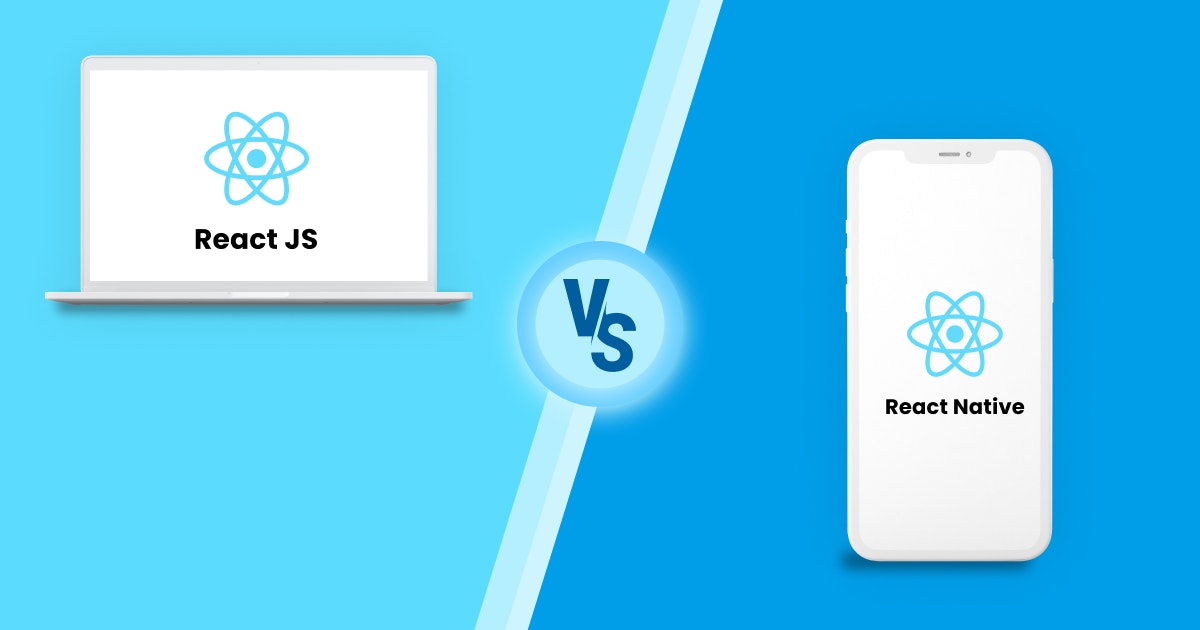React Native and React are two popular technologies that have been instrumental in building scalable web and mobile solutions. Both are the brainchild of Facebook and were developed to accelerate the creation of web and mobile user interfaces using JavaScript.
But what makes them different from each other? And what is a better choice when it comes to app development? Adding to that thought, let us discuss each technology in great detail to help you answer all your queries:
React Native
It is an open-source UI software framework used along with native platform capabilities for building apps for iOS, macOS, tvOS, Android, Android TV, Web, UWP, and Windows. React Native is written in JavaScript, C++, Python, and Objective-C.
Business advantages of working with React Native
One of the main advantages of React Native is it allows developers to build mobile apps on various platforms without compromising the overall user experience. But that is not it. The cross-platform application development technology also has other benefits:
1. Live reload feature
React Native combines all the advantages React brings, including a better user interface and the “reload” feature. This allows developers to reload a mobile app without any human intervention, thus saving time.
2. Swift and cost-effective
It is known for having just a single core API and flex-box based on a CSS concept that provides the same API for both Android and iOS app development. Because React Native can generate platform-specific code, building an MVP is faster and cheaper.
3. Ready-to-use library access
Having a good UI is one of the most vital features of your application. By using React Native’s ready-to-use libraries such as Shoutem, ShareJS, and Expo, your app can enable a smooth UI experience for its users.
4. Extensive community support
The availability of a massive team of enthusiastic JavaScript and native developers willing to share their expertise and knowledge makes it easier to stay up-to-date with the changing trends. Plus, if you get stuck during the React app development process, there is always someone to help you. There is nothing better than that!
5. Support for third-party plugins
React Native renders its support for external plugins for native and JavaScript modules. This is because some components are not available in the entire framework. React Native allows you to connect the plugin with a native or third-party module.
6. Modular and intuitive interface
React Native makes it easy for the developers to delve into someone else’s project and build upon it. This increases the flexibility within developers to do their job and simplifies the process of making upgrades to web apps, which, otherwise, can be tedious.
7. App stability
React Native simplifies the process of data binding because of which the apps are more stable, and their reliability increases. The child element does not influence the parent data in any way. And if you have to update permitted components and if you have to make any modification, then you are required to change and apply the updates without fail!
Drawbacks of React Native
Even if the features of React Native bowl you over, it is best not to get prejudiced. It would be best if you also looked at the other side of the coin. Here are the top limitations of React Native:
1. Steep learning curve
Unless you are well-acquainted with React Native or similar software development frameworks, you will have difficulty applying them in your development tasks. React Native is not for amateurs offering React app development services. Moreover, React Native takes more time to initialize the runtime for hi-tech devices, which can be hard to contain for newbies.
2. Difficult to debug
Mobile apps developed using React Native are hard to debug because they are built using C/C++, Java, or JavaScript. That is why developers must have sound knowledge of the native language of the platform.
Because the framework goes to and fro between the thread of JavaScript and the native environment, React Native app developers have to integrate the system with debugging tools like Flipper to help with the entire process.
3. New and immature
The thing is, React Native is a newbie in iOS and Android programming languages and is still in a phase of constant change. This can harm the mobile applications built using React Native, costing more to the companies to fix the product.
4. Security fragility
The cross-platform framework creates a gap in the security robustness. When developing a secure React Native application, you need to consider many factors such as environmental variables, data storage process, and SSL pinning.
It would help if you had some form of understanding of Android and iOS native platforms and general security rules in programming. Also, React Native is not the best choice for developing banking and financial applications where maintaining data confidentiality is essential.
React Native vs Ionic: Which is the Better Mobile App Framework?
Learn NowExamples of React Native in action
Despite the negatives, React Native’s advantages outweigh. No wonder so many popular brands use it for their app development efforts. Some powerful examples include:
1. Bloomberg
Before the media conglomerate moved to React Native for their mobile app development, they spent a considerable amount of time developing and updating versions of Android and iOS separately. This proved to be highly time-consuming and costly for them.
Thankfully, by creating prototypes of the app on React Native for different operating systems, Bloomberg was able to update their cross-platform apps simultaneously.
2. Facebook Ads Manager
The app has been fully built on React Native and perfectly handles the differences in ad formats,
Currencies, data formats, time zones, and so on. If you have ever used the Ads Manager, you will agree on how clean its user interface is.
Moreover, its intuitive UX and simple navigation ensure a fantastic experience for the users. The animation effects and transitions are almost flawless on the Ads Manager.
3. UberEats
Even though React Native forms a tiny part of the application, it still contributes significantly when it comes to UI and UX. When the application needed a dashboard for restaurants with functions such as push messaging, the UberEats team came up with the perfect platform built on React Native — complete with fancy yet valuable functionalities.
React
It is an open-source JavaScript library used for building user interfaces for web applications. Although responsible for only the view layer of the apps, React JS empowers developers to compose complicated UIs from small and isolated code pieces called “components.” Developed by Facebook, it is based on the JavaScript language and hence, is also known as ReactJS.
Business advantages of working with React
Given that we have just discovered the pros of React Native, does it not make you wonder what makes React stand out in the market? Well, understanding the benefits of the JavaScript library is of extreme importance when developing apps. Here we go:
1. Frequent debugging not required
The component-based architecture in React removes the need to debug the software frequently. If you edit one part of the application, it will not affect other parts. So, it is easier to turn around the testing requirements without taking too much time from experienced developers.
2. Quick development due to reusable components
One of the most significant advantages of React is its ability to reuse components. With reusable codebases, developers do not have to spend the same energy or time writing different codes for similar application components.
This fastens the development process and keeps the overhead expenses under control. No one wants to burn a hole in their pockets for being responsive.
3. Code stability with unidirectional data flow
React utilizes the power of one-way data binding to ensure the changes made in the child components do not influence the parent components. That way, every component becomes self-contained.
If you want to make changes to the smaller parts, you only need to make updates in the data model and not the entire state, which was the case previously.
This ensures the application remains unchanged even when a new major edit is introduced. The convenience makes it easier for developers to maintain a stable codebase throughout.
4. Superfast speed with virtual DOM
If you only receive data from the server, you will need more than just HTML. React uses JavaScript for HTML generation. The library uses the tree reconciliation process for rendering HTML virtually. This approach makes it possible to build web apps that run faster and more efficiently. It also means there is no need to update the whole DOM entries repeatedly.
5. Easy to test
React applications are easy to test. Developers can debug the codebase with the help of native tools. No frills, no fancies — just proper testing framework carried out correctly.
6. SEO enhancement
If you are specifically looking to create SEO-friendly web apps, then React is a fantastic option. The JavaScript library renders the web pages quickly because the loading time of the pages in a typical React app is low.
That, in turn, has a positive influence on the bounce rate of web pages. These factors have a significant impact on SERP performance. Plus, developers can also use tools such as React Router and React Helmet for building search-optimized sites quickly.
Drawbacks of React
Every coin has two sides. Similarly, React has limitations that may not make it the ideal choice for web application development. Let us take a look at areas where React falters in its performance:
1. Poor documentation
React as a technology upgrades quickly, making it difficult to document its entire growth journey properly. Due to that, developers end up writing instructions independently for their projects as new releases get rolled out.
2. Faster development pace
The frameworks evolve rapidly, and it is possible the developers do not feel comfortable re-learn the new ways of doing things daily. It may be challenging to adopt all these changes with continuous updates.
3. View part
React only covers the UI layers of the app. That is it. That means you still need to pick other technologies to access the complete tooling set for developing a project.
Examples of React in action
Just like React Native, the JavaScript library has also won the hearts of many companies with its features and benefits. Here are the top examples you should know about:
1. BBC
Their website is built using React. The technology helps them perform even on lower-end phones, support 41+ languages, support AMPs, and easily handle massive site footfall. React also powers the BBC homepage, photo gallery page, media asset page, article pages, and so on.
2. Asana
The project management tool is an early adopter of React because of its presentational and declarative properties. The library has helped them deliver the best possible experience to first-time users in the first few seconds. Asana writes most of the frontend of the web app in React and TypeScript.
3. Netflix
Everyone’s favorite choice for the weekend, Netflix utilizes React for rendering the server side of its web pages by pre-fetching the JavaScript library, especially for its signup. This boosts the overall site performance and delivers an exceptional user experience.
4. Instacart
This grocery delivery and pick-up service was initially developed as a single-page application (SPA) utilizing Underscore, Backbone, and jQuery. When scalability became an issue, the team switched the Backbone Views to React Components.
That was possible because React only displayed the View aspect of the Model-View-Controller architectures. Plus, the migration did not hamper the overall infrastructure of the website.
React Native vs. React: Key differences
Now that we have had a look at both the technologies in detail, one question remains — how different are React Native and React from each other? Sure, both have their pros and cons. However, they serve to make the app development process more efficient. In the following section, we will look at the critical differences between React Native and React:
All-in-one Guide on React Native VS Flutter
Explore NowWhich is better? React Native or React?
Both technologies are fantastic pillars for web and mobile app development. Because of their flexible functionalities and a superlative ecosystem of libraries, they are gaining prominence amongst developers with each passing day.
While React Native is the entire cross-platform framework for native app development, React is a JavaScript library, and both technologies complement each other. React Native works perfectly for giving a native feeling to your mobile apps.
On the other hand, ReactJS is optimal for app creation with high functionality and complicated calculations. Though both technologies have their limitations, it is best to do thorough research based on your business requirements and expected outcome.
Over to you
Whether you go ahead with React Native or React, you will be able to develop an app that stands the test of time. Work with our team to help your business grow, and benefit from our agile development methodology for quick and smooth product delivery.
Develop eCommerce and large enterprise apps, and create dynamic dashboards using React. Hire Intuz, a leading React Native development company, and make your app dream a reality.






